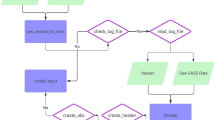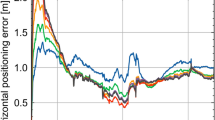Abstract
In shaded areas, Global Positioning System (GPS) signals may suffer significant degradation, making the measurements to be contaminated by different kinds of errors. These errors such as outliers arising due to multipath and line-of-sight signals can degrade the accuracy of GPS positioning. Moreover, the poor geometric constellation of satellites that the receiver is tracking may cause inverse problems, resulting in unstable and unreliable GPS positioning solutions. To tackle these problems, an iterative robust regularization method (IRRM) for the GPS positioning is proposed in this article. The IRRM employs the Cholesky factorization method to preclude computing the inverse of matrices, making it numerically stable and be easily implemented in engineering. Also included in this work is the derivation of the sufficient condition for the IRRM. Performance comparisons of the proposed algorithm with the least squares, the Cholesky factorization method for iterative least squares (CM), and the robust estimation are demonstrated via two static positioning problems. The experimental results, presented herein, exhibit the improved performance of the IRRM over conventional algorithms.









Similar content being viewed by others
References
J.S. Abel, J.W. Chaffee, Existence and uniqueness of GPS solutions. IEEE Trans. Aerosp. Electron. Syst. 27, 952–956 (1991)
I. Arasaratnam, S. Haykin, Cubature Kalman filters. IEEE Trans. Automat. Control 54, 1254–1269 (2009)
S. Bancroft, An algebraic solution of the GPS equations. IEEE Trans. Aerosp. Electron. Syst. AES–21, 56–59 (1985)
I. Biton, M. Koifman, I.Y. Bar-Itzhack, Improved direct solution of the global positioning system equation. J. Guid. Control Dynam. 21, 45–49 (1998)
R.L. Burden, J.D. Faires, Numerical Analysis, 9th edn. (Cengage Learning, Boston, 2010)
E. Choi, D.A. Cicci, Analysis of GPS static positioning problems. Appl. Math. Comput. 140, 37–51 (2003)
J. Chaffee, J. Abel, On the exact solutions of pseudorrange equations. IEEE Trans. Aerosp. Electron. Syst. 30, 1021–1030 (1994)
B.T. Fang, Comments on “Existence and uniqueness of GPS solutions” by J. S. Abel and J. W. Chaffee. IEEE Trans. Aerosp. Electron. Syst. 28, 1163 (1992)
K. Fallahi, C.T. Cheng, M. Fattouche, Robust positioning systems in the presence of outliers under weak GPS signal conditions. IEEE Syst. J. 6, 401–413 (2012)
F.E. Grubbs, Procedures for detecting outlying observations in samples. Technometrics 11, 1–10 (1969)
C.J. Guo, Z. Tian, X.C. Zhang, Z. Chen, Combination forecasting algorithm and effectiveness evaluation for DGPS carrier phase and pseudo-range correction prediction, in Proceedings of the 25th International Technical Meeting of the Satellite Division of The Institute of Navigation (2012), p. 2316–2325.
N.J. Higham, Accuracy and Stability of Numerical Algorithms, 2nd edn. (Society for Industrial and Applied Mathematics, Philadelphia, 2002)
G.W. Huang, Q. Zhang, G.C. Xu, Real-time clock offset prediction with an improved model. GPS Solut. 18, 95–104 (2014)
D.J. Jwo, Outliers resistance estimator for GPS positioning—the neural network approach. J. Navig. 60, 129–145 (2007)
K. Krause, A direct solution to GPS-type navigation equations. IEEE Trans. Aerosp. Electron. Syst. AES–23, 225–232 (1987)
A. Kangas, P. Stoica, T. Söderström, Large-sample analysis of MUSIC and min-norm direction estimations in the presence of model errors. Circ. Syst. Signal Process. 15, 377–393 (1996)
J.B. Lundberg, Alternative algorithms for the GPS static positioning solution. Appl. Math. Comput. 119, 21–34 (2001)
J.L. Leva, An alternative closed-form solution to the GPS pseudo-range equations. IEEE Trans. Aerosp. Electron. Syst. 32, 1430–1439 (1996)
V.A. Morozov, Method for Solving Incorrectly Posed Problems (Springer Science & Business Media, New York, 1984)
P. Miquel, P.I. Antonio, A.L. Miguel, Mutual information optimization and capacity evaluation in MIMO systems with magnitude knowledge and phase uncertainty. Circ. Syst. Signal Process. 26, 527–549 (2007)
P.S. Noe, K.A. Myers, T.K. Wu, A navigation algorithm for low cost GPS receiver. J. Inst. Navig. 25, 256–264 (1978)
I. Progri, Geolocation of RF Signals: Principles and Simulations (Springer Science & Business Media, New York, 2011)
T. Perala, R. Piche, Robust extended Kalman filtering in hybrid positioning applications, in 4th Workshop on Positioning, Navigation and Communication (2007), p. 55–63.
Z. Sheng, R. Xu, Inverse problems in GPS positioning and numerical computation (I): Regularization method, in IEEE Symposium on Robotics and Applications (2012), p. 214–216.
R. Stahish, Z. Liu, R. Jeffrey, Regularization parameter selection for nonlinear iterative image restoration and MRI reconstruction using GCV and SURE-Based methods. IEEE Trans. Image Process. 21, 3659–3672 (2012)
F. Sadjadi, Radar beam sharpening using an optimum FIR filter. Circ. Syst. Signal Process. 19, 121–129 (2000)
H.B. Tong, G.Z. Zhang, G. Ou, Iterative reweighted recursive least squares for robust positioning. Electron. Lett. 48, 789–791 (2012)
A.N. Tikhonov, V.Y. Arsenin, Solutions of Ill-Posed Problems (V. H. WINSTON & SONS, Washington, 1977)
J. Wu, H. Zhang, Y. Shi, \(H_{2}\) state estimation for network-based systems subject to probabilistic delays. Signal Process. 92, 2700–2705 (2012)
X. C. Zhang, A novel cubature Kalman filter for nonlinear state estimation, in Proceedings of the 52nd IEEE Conference on Decision and Control (2013), p. 7797–7802.
H. Zhang, Y. Shi, A.S. Mehr, On \(H_{\infty }\) filtering for discrete-time Takagi-Sugeno fuzzy systems. IEEE Trans. Fuzzy Syst. 20, 396–401 (2012)
H. Zhang, Y. Shi, A.S. Mehr, Parameter-dependent mixed \(H_{2}\)/\(H_{\infty }\) filtering for linear parameter-varying systems. IET Signal Process. 6, 697–703 (2012)
H. Zhang, Y. Shi, A.S. Mehr, Robust weighted \(H_{\infty }\) filtering for networked systems with intermittent measurements of multiple sensors. Int. J. Adapt. Control Signal Process. 25, 313–330 (2011)
H. Zhang, Y. Shi, M. Liu, \(H_{\infty }\)switched filtering for networked systems based on delay occurrence probabilities. J. Dyn. Syst. Meas. Control 135, 061002-1–061002-5 (2013)
H. Zhang, Y. Shi, Parameter-dependent \(H_{\infty }\)filtering for linear time-varying systems. J. Dyn. Syst. Meas. Control 135, 021006-1–021006-7 (2013)
L. Zhang, S.X. Huang, C. Shen, W.L. Shi, Vibrational assimilation in combination with the regularization method for sea level pressure retrieval from QuickSCAT scatterometer dada I: Theoretical frame construction. Chin. Phys. B 20, 119201-1–119201-7 (2011)
D.S. Zheng, On matrix unitarily invariant norm condition number. J. Comput. Math. 2, 121–128 (1998)
J.W. Zhou, Classical theory of errors and robust estimation. Acta Geod. Cartographica Sin. 2, 115–120 (1989)
Author information
Authors and Affiliations
Corresponding author
Appendix
Appendix
Numerical stability often refers to the accuracy of an algorithm in the presence of rounding errors. An algorithm is unstable if rounding errors cause large errors in the result. In the appendix, we are going to have a brief discussion on the numerical stability.
Several applications in engineering, physics, and applied mathematics can be modeled with the help of the generalized eigenvalue problem (GEP). Most of them concern the largest eigenvalue and the associated eigenvector. However, for a singular system, the smallest eigenvalue is equally of importance to the largest one. It is numerically unstable to solve them by simply solving for the generalized inverse of \({\varvec{A}}\).
Consider the following two systems: (39) and (40),
and
where (39) is derived from (4), and (40) is the associated regularization system.
With regard to system (39), \({\tilde{\varvec{N}}}={\varvec{A}}^T{\bar{\varvec{P}}\varvec{A}}\) is almost singular for ill-conditioned problems. If \(\tilde{\lambda }_{\max } \) and \(\tilde{\lambda }_{\min } \) denote the maximum and the minimum eigenvalues of \({\tilde{\varvec{N}}}\), respectively, then
where the symbol “\(\sim \)” denotes the matrix similarity; \(\bullet \) stands for the other eigenvalues, such that \(\bullet \in \left[ {\tilde{\lambda }_{\min } ,\;\tilde{\lambda }_{\max }} \right] \). We do not consider the specific values of \(\bullet \) since they do not have any effect on the following discussions.
Corresponding to the analysis of Sect. 3, we use the 2-norm condition number to describe the stability of the proposed method. It is well known that if the condition number is close to 1, the matrix is well-conditioned which means its inverse can be computed with high accuracy. If the condition number is much larger than 1, then such a matrix is almost singular, and the computation of its inverse, or solution of the system, is prone to large numerical errors.
The 2-norm condition number of (39) is given by
By introducing the stable function, we have
The associated condition number of (40) is
Clearly, the ill-conditioning has been weakened. Hence, the solution of the regularization system is more numerically stable.
Rights and permissions
About this article
Cite this article
Zhang, XC. An Iterative Robust Regularization Method for GPS Positioning. Circuits Syst Signal Process 33, 2895–2915 (2014). https://doi.org/10.1007/s00034-014-9775-8
Received:
Revised:
Accepted:
Published:
Issue Date:
DOI: https://doi.org/10.1007/s00034-014-9775-8




